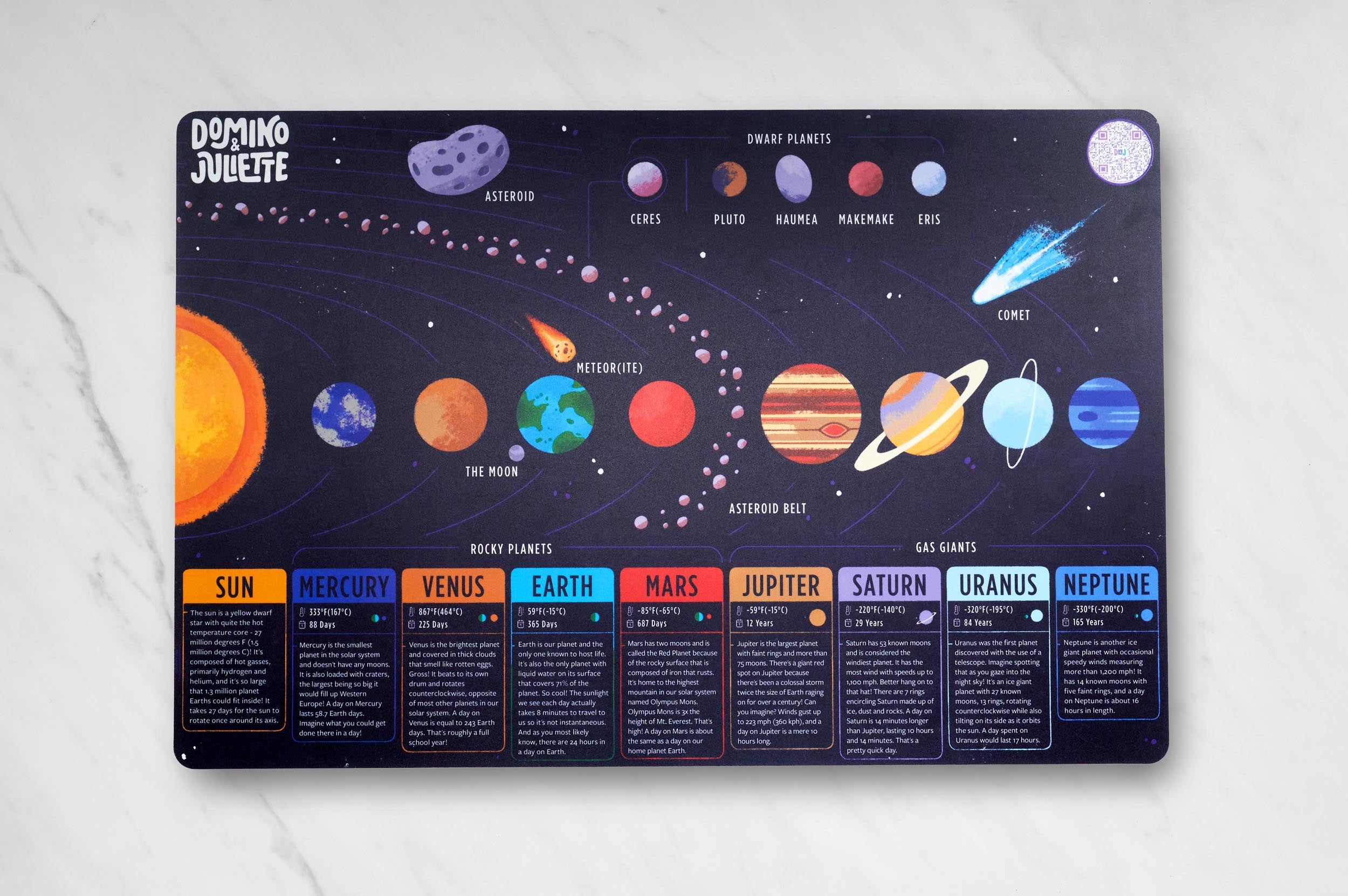
Welcome to the Bright Idea Zone!One toy, many ways to play
Unearth intriguing facts and information that will delight learners of all ages and enhance the placemat experience! Do you want to share the fun with your children off the screen? Simply click to download the printer-friendly children’s version of this page or access your bonus printable coloring pages. Get ready to embark on an educational adventure!
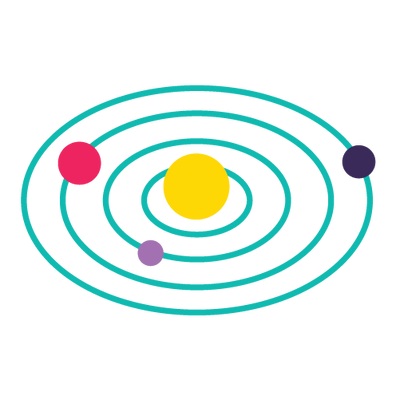
Zoom! Zoom! Zoom! We’re going to the moon! In 5-4-3-2-1, blastoff! Welcome to our amazing solar system, a cosmic neighborhood of planets, moons, and other space objects that all circle around a star we like to call the Sun. Did you know the Sun is a star? Pretty cool, huh? Grab your helmet and turn on your curiosity – we’re going to discover so many incredible facts together as we zoom around the Solar System!
Before we start, let's learn a few important words to help us explore our solar system:
When something goes around another thing in space, we say that it orbits. All the planets in our solar system, including Earth, orbit the Sun. It's like they're playing an endless game of "Ring Around the Rosie" with the Sun in the center!
Moons are objects (coming in many shapes and sizes) that orbit planets. They’re like little helpers that keep the planets company! Our Earth has one large, round moon, but some planets have many moons.
A star is a gigantic, glowing ball of gas that lights up the sky like a twinkling diamond. The gas in a star is so hot it creates a special kind of energy called light. This makes the star shine! Our Sun is a star, and it's the closest one to Earth. Because it's so close, it looks much bigger and brighter than other stars.
Our solar system has eight planets that are outta-this-world (literally): Mercury, Venus, Earth, Mars, Jupiter, Saturn, Uranus, and Neptune. They all have their own unique features, like rings, storms, and even ice! Plus, there are other cool things like comets, asteroids, and dwarf planets zipping about this cosmic neighborhood.
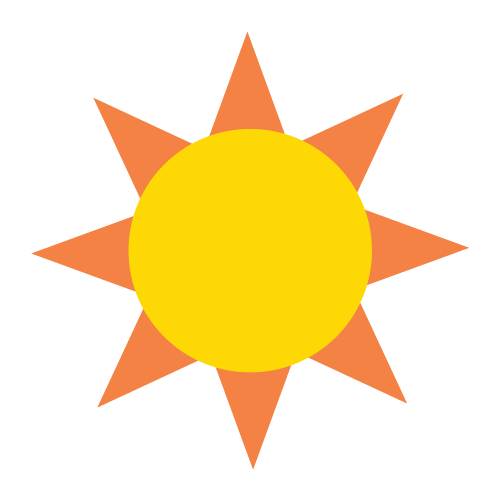
Let’s discover the planets in the solar system!
A planet is a big, round object that orbits the Sun. To be called a planet, it needs to meet three special rules.
- First, it has to circle the Sun and not any other object, like a star or another planet.
- Second, it must be big enough so that its own gravity, or energy, pulls it into a round shape, like a ball.
- Finally, it must have cleared its path around the Sun, which means there aren't many other smaller objects or rocks sharing its orbit.
Remember dwarf planets, stars, and moons previously mentioned? Dwarf planets are very similar to planets, but they haven't cleared their path around the Sun. That's why they aren't considered regular planets.
Stars, like the Sun, are big balls of gas that create their own light and heat through a process called nuclear fusion.
Planets and dwarf planets orbit stars, but stars don't orbit anything—they just stay in one place in space. Moons are smaller objects that go around planets instead of the Sun. They can come in different shapes and sizes, and some planets have many moons while others have none.
So, when you think of a planet, remember it's a big, round object that orbits the Sun, has a clear path, and doesn't make its own light like a star.
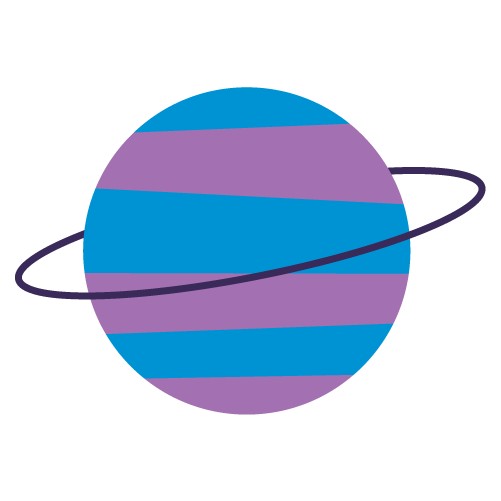
It’s the Rocky Planets vs. the Gas Giants!
They really do sound like Major League Baseball teams, but rocky planets and gas giants represent two distinct types of planets found in our solar system. Rocky planets, also known as terrestrial planets, are characterized by solid, dense compositions primarily consisting of metals and silicate rock. They are relatively small in size and have thin atmospheres. Earth, Mars, Venus, and Mercury are prime examples of rocky planets.
In contrast, gas giants are massive planets composed predominantly of light elements such as hydrogen and helium. They possess thick, deep atmospheres and lack a well-defined solid surface, often containing dense cores. Jupiter and Saturn are the most notable gas giants in our solar system. While rocky planets boast features like mountains, valleys, and volcanoes, gas giants exhibit immense weather systems and powerful magnetic fields.
Mercury:
Small and mighty! Mercury is the smallest planet in our solar system. It’s a little bigger than Earth’s Moon and the closest to the Sun. You’d think it’d be the hottest planet, but it’s not! Venus is hotter thanks to its dense atmosphere. If you stood on the surface of Mercury, the Sun would appear more than 3x as large as it looks from Earth. Not only that, the sunlight would be as much as 7x brighter! It is unlikely that life could survive on Mercury because of solar radiation and extreme temperatures.
Mercury has a solid surface that is covered with craters like our Moon. It has a thin atmosphere, and it doesn’t have any moons or rings. Mercury likes to keep things simple. Because of Mercury's elliptical – egg-shaped – orbit, and sluggish rotation, the Sun appears to rise briefly, set, and rise again from some parts of the planet's surface. The same thing happens in reverse at sunset.
Mercury is named after the messenger for the Roman gods. The Romans believed that gods and goddesses were in charge of everything on Earth. The Roman Mercury had wings on his helmet and shoes. He could travel very quickly from place to place. While Mercury’s personal rotation is slow-going, its orbit around the Sun is very quick, hence the name “Mercury”!
Venus:
Won’t you be my neighbor? Venus is the second planet from the Sun and Earth’s closest planetary neighbor. Even though Mercury is closer to the Sun, Venus is the hottest planet in our solar system. Its thick atmosphere traps heat, making it feel like a furnace on the surface. It’s so hot on Venus a metal lead pipe would melt! Venus is a Rocky Planet covered in mountains and volcanoes and is sometimes called Earth’s twin because it’s similar in size and structure, however, they are very different in other ways. For example, in addition to being extremely hot, Venus is unusual because it spins in the opposite direction of Earth and most other planets. This means the Sun rises in the west and sets in the east, opposite of what we see on Earth. It also has a very slow rotation making its day longer than its year.
Did you know Venus was the first planet explored by a spacecraft and was intensely studied early in the history of space exploration? Venus was also the first planet whose surface was reached by a spacecraft from Earth. The intense heat means landers have only survived for a couple of hours.
Venus was named after the Roman goddess of love and beauty. It's the only planet named after a female god.
Earth:
Home sweet home! Our home planet Earth is a rocky, terrestrial planet with one moon and no rings. It has a solid and active surface with mountains, valleys, canyons, plains and so much more. Earth is special because it is an ocean planet with water covering 70% of its surface!
Earth's atmosphere is made mostly of nitrogen and has plenty of oxygen for us to breathe. The atmosphere also protects us from incoming meteoroids, most of which break up before they can hit the surface. (Phew!)
Many spacecraft orbit and study the Earth from above. They observe the atmosphere, ocean, glaciers, and the land…All of the planets, except for Earth, were named after Greek and Roman gods and goddesses. The name Earth is a German word which simply means “the ground.”
Mars:
Is your brother really from Mars? We can guarantee he is not! Mars is a cold desert world. It is half the size of Earth and was named by the ancient Romans after their god of war because the reddish color is reminiscent of bloodshed that comes during wartime. Like Earth, Mars has seasons, polar ice caps, volcanoes, canyons, and weather. It has a very thin atmosphere made of carbon dioxide, nitrogen, and argon.
There are signs of ancient floods on Mars, but now water mostly exists in icy dirt and thin clouds. On some Martian hillsides, there is evidence of liquid salty water in the ground.
Mars has two moons named Phobos and Deimos and has no rings. At this time, Mars' surface cannot support life as we know it. Current missions are determining Mars' past and future potential for life. How neat is that?
Mars was named by the ancient Romans for their god of war because its reddish color is frequently associated with the red blood of war.
Jupiter:
Hey big guy! Jupiter is the biggest planet in our solar system. If Earth were the size of a grape, Jupiter would be the size of a basketball! It's similar to a star, but it never got big enough to start burning. Jupiter is a gas giant and doesn't have a solid surface, but it may have a solid inner core about the size of Earth. Jupiter also has rings, but they're too faint to see very well.
Covered in swirling cloud stripes, Jupiter has big storms like the Great Red Spot, which has been going for hundreds of years.
Jupiter cannot support life as we know it, however, some of Jupiter's moons have oceans beneath their crusts that might support life!
Jupiter, being the biggest planet, gets its name from the king of the ancient Roman gods, Zeus – or his Roman equivalent, Jupiter – who rules over Mount Olympus and is the god of thunder and lightning, as well as law and order.
Saturn:
So big it has its own solar system (but not as big as Jupiter)! Nine Earths side by side would almost span Saturn’s diameter. That doesn’t include Saturn’s rings! Saturn is its own mini solar system with 53 known moons with an additional 29 moons awaiting confirmation of their discovery—that is a total of 82 moons!
Saturn isn’t the only planet to have rings, but it definitely has the most beautiful ones with seven of them with large gaps between them! The rings we see are made of groups of tiny ringlets composed of chunks of ice and rock. Like Jupiter, Saturn is mostly a ball of hydrogen and helium. It’s the farthest planet from Earth discovered by the unaided human eye (can be seen without using a telescope). Because of this, Saturn has been known since ancient times. The planet is named for the Roman god of agriculture and wealth, who was also the father of Jupiter.
Uranus:
“To be or not to be,” that is the question! Uranus has 27 known moons named from the works of Alexander pope and, yes, William Shakespeare. Uranus also has 13 faint rings with the inner rings being dark and narrow and the outer rings being brightly colored and easier to see. It’s composed of water, methane and ammonia fluids above a small rocky center. Similar to Jupiter, its atmosphere is made of hydrogen and helium, and since it also has methane, Uranus is blue in color! To put its size into perspective, if Earth were a large apple, Uranus would be the size of a basketball. It’s about four times wider than Earth.
Did you know Uranus was discovered by one of the most famous astronomers of the 18th century? Sir William Herschel discovered this beautiful blue planet in 1781 along with another 800 double stars and 2,500 nebulae. Uranus was named after the Greek god of the sky.
Presently, Uranus remains a lonely planet (poor buddy). Voyager 2 is the only spacecraft to fly by Uranus. Not a single spacecraft has orbited this distant planet to study it up close. Perhaps that could be you?
Neptune:
Did Uranus just duplicate itself? Sort of! Neptune is also made of hydrogen, helium and methane, is similar in size AND is blue in color. Neptune is dark, cold, very windy and the last of the planets in our solar system. It's more than 30 times as far from the Sun as Earth is making it invisible to the naked eye. In 2011 Neptune completed its first 165-year orbit since its discovery in 1846.
Neptune has 6 rings and 14 known moons which are named after sea gods and nymphs in Greek mythology.
Neptune is named after the Roman god of the sea.
Teeny Tiny Dwarf Planets
Dwarf planets are celestial objects, or outer space objects, that orbit the Sun, have enough mass to assume a nearly round shape, and share their orbital path with other bodies. Though they appear to be regular planets in some aspects, they do not meet all the criteria for classification as a full-fledged planet. For example, unlike a planet, they have not cleared their orbits of other debris.
Some well-known dwarf planets in our solar system include Ceres, Pluto, Haumea, Makemake, and Eris. Was anyone else hoping they’d be named Happy, Sleepy, Doc, Grumpy and Dopey? Just us?
Ceres is located in the asteroid belt between Mars and Jupiter and is the only dwarf planet located in the inner solar system. It’s wide in diameter, about 590 miles (940 km) and is thought to house an ocean as it contains significant amounts of water. NASA's Dawn spacecraft visited Ceres in 2015 and discovered bright spots in a crater called Occator Crater, which are likely deposits of sodium carbonate.
Moving to the next dwarf planet, did you know we once had a 9th planet in our cosmic neighborhood? Located in the Kuiper Belt, Pluto was reclassified as a dwarf planet in 2006. It has a heart-shaped region called Tombaugh Regio that’s rich in nitrogen, carbon monoxide, and methane ices. In 2015, NASA's New Horizons mission conducted a historic flyby of Pluto and captured detailed images that provided valuable information on its geology, atmosphere and another possible subsurface ocean!
Haumea is another unique, elongated dwarf planet also found in the Kuiper Belt. Its distinctive ellipsoid shape is caused by a very fast rotation that causes Haumea to spin a full spin in less than 4 hours. It has two known moons, Hi'iaka and Namaka, and is thought to be made up of primarily rock and water ice.
Makemake (oh we can hear the giggles) is another dwarf planet located in the Kuiper Belt and is reddish in color due to frozen methane on its surface and named after the creation deity of the Rapa Nui people of Easter Island. It’s the 3rd largest dwarf planet next to Eris and Pluto with a small moon orbiting it named the MK2. The MK2 was discovered in 2016.
Eris is the largest dwarf planet in our solar system! It’s slightly larger than Pluto, and is located in a region beyond the Kuiper Belt called the scattered disc. The discovery of Eris sparked conversation about what makes a planet a planet and ultimately resulted in Pluto losing its planet status in 2005. Eris is made up of methane and nitrogen ices that make it super shiny and reflective and a small moon named Dysnomia.

Like Peanut Butter and Jelly: The Moon and the Earth
The Moon is a big, round rock that orbits our planet Earth. It’s our closest neighbor in space and is about one-fourth the size of Earth. As you probably already know, the Moon is shiny but it’s not shiny in and of itself, it’s shiny because it’s reflecting the light from the Sun! It’s like the Sun’s mirror (cue Justin Timberlake “Mirrors”).
Every night, the Moon changes shape because we see different parts and amounts of it being lit by the Sun. These shapes are called Moon phases and include the crescent Moon, the half Moon, and the full Moon. The full Moon is when it looks like a big, round ball of light in the sky.
Did you know the Moon’s gravity is weaker than the Earth’s? This explains why astronauts could jump really high when they landed on its surface! If you weighed 100 pounds on Earth, you’d only weigh about 17 pounds on the Moon. Because the Moon doesn’t have wind or water, those jumping footprints left behind from the 12 US astronomers between the years of 1969 and 1972 could stay there for millions of years! The flag and the car called the Lunar Rover have also been left behind. If you visited the Moon, what would you want to leave behind?
The Moon has many craters, or big holes made by space rocks called meteoroids crashing into its surface. It also has tall mountains just like Earth, with the highest one being taller than Mount Everest, the tallest mountain on Earth! Crazy!
A Belt Like No Other: Let’s Discover Asteroids!
Between Mars and Jupiter is a region called the Asteroid Belt. Asteroids are small, rocky celestial objects, or remnants of the early solar system, orbiting the Sun. They’ve provided critical knowledge into the formation and evolution of the solar system. Some are a few meters and others are hundreds of kilometers in diameter! The largest known asteroid is Ceres, which is about 590 miles (940 km) across and is also classified as a dwarf planet. Asteroids are composed of various materials, including rock, metal, and carbonaceous substances. In recent years there has been a lot of talk about asteroid mining to obtain these precious metals and minerals and even water. This would revolutionize space exploration and the global economy!
Near-Earth Asteroids (NEAs): Some asteroids have orbits that come just a bit too close to home. These asteroids are known as Near-Earth Asteroids and pose a risk, albeit low, of colliding with our planet. Yikes!
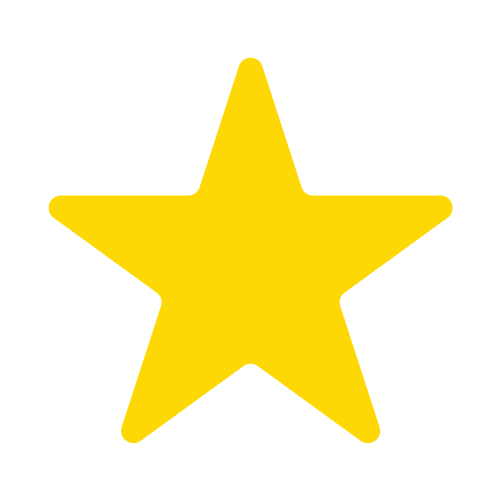
Wish Upon A Shooting Star!
A “shooting star” is simply a small object or fragment of an object that enters the Earth’s atmosphere at a high speed. These “shooting stars” are actually called meteors, and as they travel through the atmosphere, friction heats them up and causes them to emit a light streak or tail. Fragments of meteors that survive and land on Earth are called meteorites. The primary difference between a meteor and a meteorite lies in their location: meteors are observed in the atmosphere, while meteorites are found on Earth's surface.
At certain times of the year, Earth “takes a shower” and passes through the debris left by comets. This results in more visible meteors in the sky and the result is a “meteor shower.” Specific names are often given to the meteor shower corresponding to the constellation, or group of stars, from which they originate. Examples include Perseids and Leonids.
Did you know some meteorites found on Earth are older than the planet itself? They provide valuable information about the early solar system's makeup and conditions.
A dirty snowball is coming this way!
Ice and dust and rocks, oh my! A comet is a small celestial object composed of ice, dust, and rocky material that orbits the Sun. As it gets closer to the Sun, the Sun causes the ice to vaporize and creates a neat glowing coma, or a cloud of gas and dust, and gives it a tail that (get this!) can extend millions of kilometers! And what’s better than one tail? Two tails! Comets often have two tails: a dust tail that’s bright and curved and an ion tail that’s typically fainter and straighter and always points away from the Sun due to solar wind.
Some comets have super long orbital periods taking up to millions of years to complete a single orbit around the Sun. Others known as short-period comets, complete their orbits within 200 years. Sounds pretty long either way, right?
Halley's Comet is a well-known comet visible from Earth every 75-76 years, and Comet Hale-Bopp is another that was visible to the naked eye for a record-breaking 18 months in 1996-1997.
The European Space Agency's Rosetta mission made history in 2014 by becoming the first spacecraft to orbit a comet and deploy a robotic lander, Philae, onto its surface. The information gathered from this mission provided lots of insight into the composition and structure of comets. Comets are also thought to be remnants from the early solar system, providing insight into its formation and evolution.
Now that you have explored this cosmic neighborhood we are currently orbiting in, flip your mat over to make even more discoveries about Space Exploration!